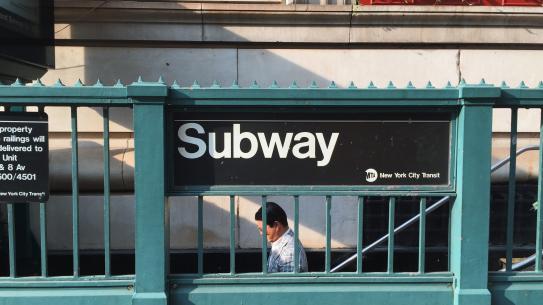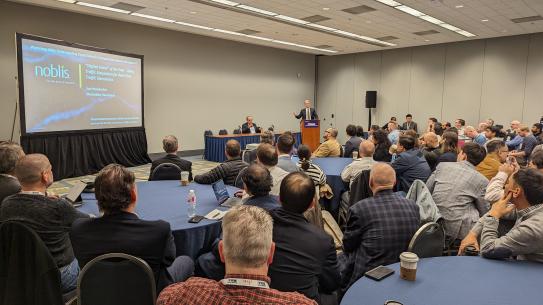
Jingqin Gao hoped she might rest for at least a couple of weeks after earning her doctoral degree in transportation planning and engineering. It had been a busy and eventful few years for her, including presiding over Tandon’s student chapters of the Institute of Transportation Engineers (ITE) and Intelligent Transportation Society (ITS), hosting the ITE Northeastern District’s annual Collegiate Traffic Bowl Competition and mentorship lunch, organizing panel discussions for women in transportation, helping oversee TransportationCamp (a popular event drawing hundreds of students and professionals each year), serving as a teaching assistant, and conducting research related to traffic simulation modeling, big data and machine learning approaches for transportation, connected and autonomous vehicles, congestion management, transportation economics, and parking management.
There were many rewards along the way: under Gao’s leadership, Tandon’s ITE chapter was named the best in the region, and she received the Dr. Louis J. Pignataro Memorial Transportation Education Award and the Women’s Transportation Seminar (WTS) National Leadership Legacy Award. Still, it had been a demanding endeavor, and she looked forward to some well-deserved relaxation before diving back into work.
At C2SMART (Connected Cities with Smart Transportation), Tandon’s Tier 1 USDOT University Transportation Center, they had a different idea: immediately after defending her dissertation in late February, Gao was tapped to start work as a C2SMART Postdoctoral Associate, taking the lead on planning and developing data-driven transportation solutions and techniques within the framework of multiple research programs and projects.
Luckily, she’s adept at multitasking. Her current job involves studying the impacts of COVID-19 on transportation systems, quantifying the effects of double parking, helping New York City’s Department of Transportation pilot a program to assist visually impaired pedestrians, improving bus traffic in the Lincoln Tunnel, and much more.
Gao — who earned her master’s degree at Tandon in 2012 — worked as a traffic engineer and onsite NYCDOT consultant before deciding to return to her alma mater for a Ph.D. in 2015. She has co-authored several papers with C2SMART’s director, Kaan Ozbay, whom she considers an important mentor, and welcomes the chance to continue working alongside him. As a woman, she also welcomes the chance to mentor other women at Tandon and encourage them to enter a field that has been exceedingly fulfilling for her. “I’ve done internships where I’ve been the only woman in the room, so it’s great to be a part of C2SMART, which is working to change that paradigm, just as it’s working to create the transportation solutions the world needs,” she says.
Research News
NYC speed cameras take six months to change driver behavior, effects vary by neighborhood
New York City's automated speed cameras reduced traffic crashes by 14% and decreased speeding violations by 75% over time, according to research from NYU Tandon's C2SMARTER published in Transportation Research Interdisciplinary Perspectives that tracked more than 1,800 cameras across school zones from 2019 to 2021.
With speeding contributing to approximately one-third of all motor vehicle fatalities nationwide, these findings translate to potentially hundreds of lives saved in America's most densely populated city.
The study from C2SMARTER — a US Department of Transportation Tier 1 University Transportation Center — complements the NYC Department of Transportation's (NYC DOT) own 2024 report, which similarly found a 14% reduction in injuries and fatalities at camera locations compared to control sites without cameras.
While the NYC DOT report provides valuable citywide statistics, the C2SMARTER study reveals several critical insights: cameras typically reach a strong level of effectiveness within six months, effectiveness patterns vary geographically across the city, and changes in driving behavior may exhibit a ‘time-lag’ effect.
"Our research methodology provided an in-depth short-term and long-term analysis of these cameras, taking into consideration the continuous installation of new cameras," explained Jingqin Gao, Assistant Director of Research at C2SMARTER and the paper's lead author. "By tracking each camera's performance over time, we uncovered spatial and temporal patterns that may be less visible in citywide data, providing officials additional insights on the longitudinal effects and more strategic positioning of future cameras to maximize the program’s effectiveness."
NYC's speed camera program has evolved from a 20-camera pilot in 2013 to a network of 2,200 cameras across all 750 school zones by 2023 — expanding from limited hours (6 a.m.-10 p.m. weekdays) to 24/7 operation in 2022. C2SMARTER's research examines the critical 2019-2021 timeframe when the program first achieved citywide scale.
What sets this study apart is its longitudinal approach — tracking fixed camera sites over extended periods. The research revealed most cameras achieve their safety purpose within six months, with violations dropping and staying low — showing drivers have changed behavior to drive more slowly and the cameras are working as intended, to deter speeding.
"Our long-term analysis identified four distinct patterns in how specific camera installations performed," said Gao. "Cameras at some locations showed consistent reductions at varying magnitudes in two groups, with a surge in speeding tickets during COVID. A third group exhibited a relatively modest effect but nearly curbed speeding behaviors within 1.5 years, despite COVID-19 impacts, and a small set of camera sites saw marginal impact in the first few months but experienced dramatic COVID-era speeding increases," Gao added. "Our short-term analysis also provided evidence of a 'time-lag effect,' where driver compliance improved gradually rather than immediately after installation."
The C2SMARTER team led by its Director Kaan Ozbay, professor in the NYU Tandon Civil and Urban Engineering Department (CUE), pioneered the application of Survival Analysis with Random Effect (SARE) for before-and-after evaluation of traffic safety treatments. This statistical method models the time intervals between crashes rather than simply counting them. Their findings were published in a series of papers in top traffic safety journals, including Risk Analysis and Safety Science.
This approach alleviates the challenge posed by the need for waiting years to collect data needed to conduct before and after analysis using traditional statistical approaches. The significantly shorter time periods of data collection potentially saves lives by allowing traffic engineers to re-evaluate their deployment approaches of safety treatments.
"The SARE method can accommodate the different implementation dates of speed cameras,” said Di Yang, a paper co-author who is currently an assistant professor at Morgan State University. Yang received his Ph.D. from CUE in 2022 under Ozbay’s advisement. “This approach allows us to better leverage the time intervals between crashes to estimate the change in crash rates before and after implementing speed cameras.”
These nuanced findings provide critical guidance for policymakers and urban planners across the country. Rather than a one-size-fits-all approach, the research points to the need for targeted, data-driven strategies that combine enforcement with engineering solutions tailored to specific locations.
"This isn't just about issuing tickets," concluded Ozbay. "It's about using data analytics and advanced statistical methods to save lives on our streets, especially in dense urban areas where a single speeding vehicle can have devastating consequences."
The study contributes to C2SMARTER's work to improve NYC transportation systems’ efficiency and safety. Among its projects, the Center has created a "digital twin" of Harlem with the NYC Fire Department to reduce emergency response times; tested and deployed weigh-in-motion technology to extend the Brooklyn Queens Expressway's lifespan; and developed performance measures for NYC Department of Transportation's off-hour delivery program.
In addition to Gao, Ozbay and Yang, the paper's authors include Chuan Xu and Smrithi Sharma, both with C2SMARTER and NYU Tandon’s Department of Civil and Urban Engineering at the time of the research.
Gao, J., Yang, D., Xu, C., Ozbay, K., & Sharma, S. (2025). Assessing the impact of fixed speed cameras on speeding behavior and crashes: A longitudinal study in New York City. Transportation Research Interdisciplinary Perspectives, 30, 101373.
Mobility in post-pandemic economic reopening under social distancing guidelines: Congestion, emissions, and contact exposure in public transit
The COVID-19 pandemic has raised new challenges for urban transportation — “back to the office” policies, staggered teleworking hours, and social distancing requirements on public transit may exacerbate traffic congestion and emissions due to shifts in travel modes and behaviors.
A team consisting of C2SMART members Ding Wang, Yueshuai Brian He, Jingqin Gao, Joseph Chow, Kaan Ozbay, and researchers from Cornell University, proposed a simulation tool for evaluating trade-offs between traffic congestion, emissions, and COVID-19 spread mitigation policies which impact travel behavior. Their research has been published in the November 2021 volume of the Transportation Research Part A journal.
Using New York City as a case study, the team used open-source agent-based simulation models to evaluate transportation system usage. Additionally, a Post Processing Software for Air Quality (PPS-AQ) estimation was used to evaluate air quality impacts associated with pandemic-related transportation changes.
The research also estimated system-wide contact exposure, finding that the social distancing requirement on public transit to be effective in reducing exposure but having negative impacts on congestion and emission within Manhattan and in neighborhoods at transit and commercial hubs.
The proposed integrated traffic simulation models and air quality estimation models may have the potential to help policymakers evaluate the impact of policies on traffic congestion and emissions and also to help identify transportation “hot spots,” both temporally and spatially.
The research was conducted with the support of the C2SMART University Transportation Center, and funded in part by the 55606–08-28 UTRC-September 11th grant as well as a grant from the U.S. Department of Transportation’s University Transportation Centers Program.





